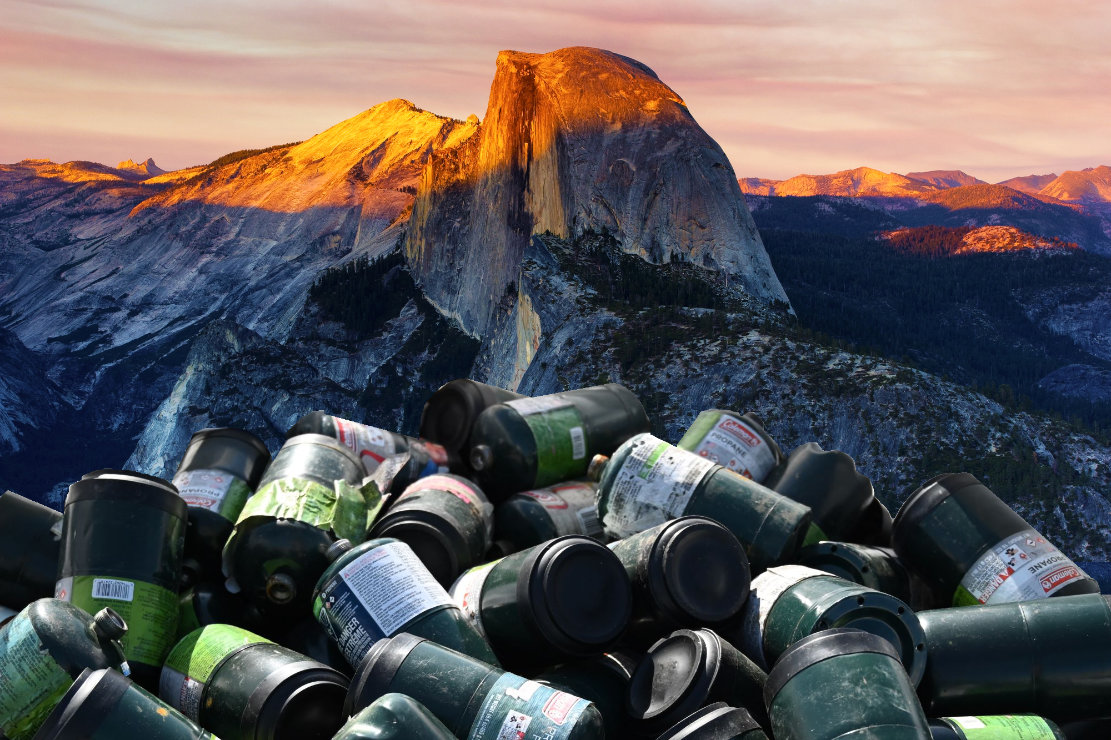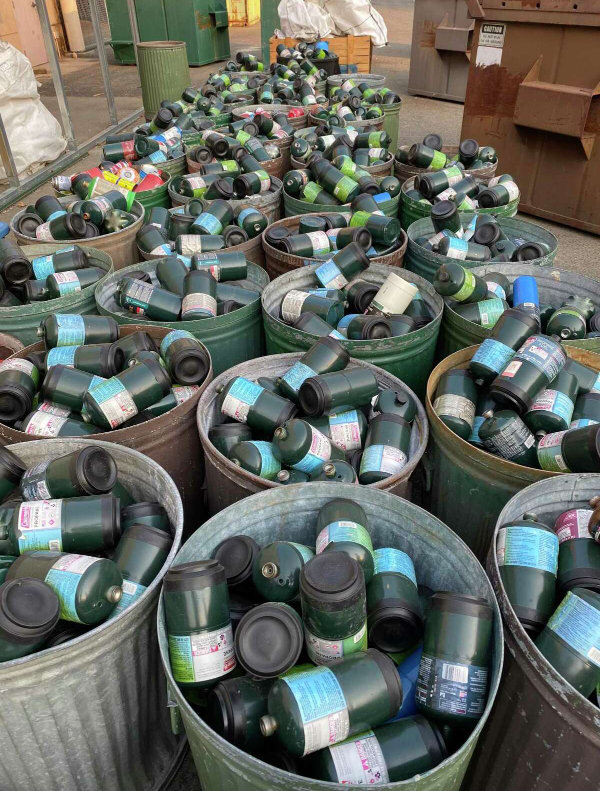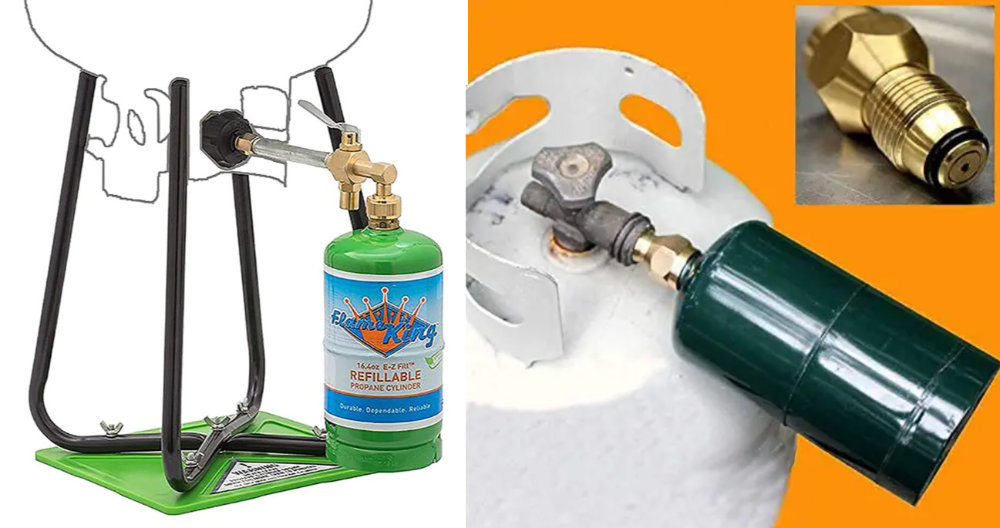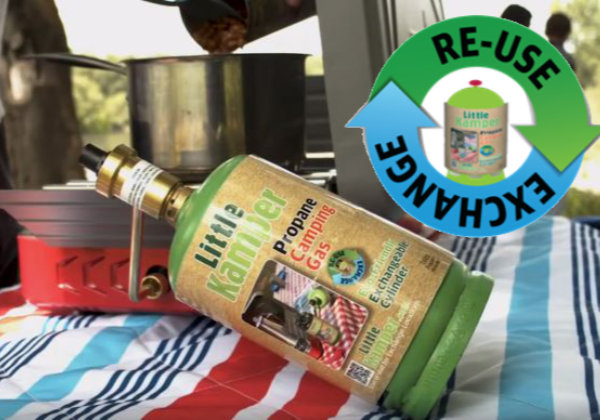
LIKE MANY NOMADS, I started vandwelling with a 20-pound propane tank to fuel my stove and heater. A few years later I realized I didn’t use all that much propane — about a half tank a year. I had also gotten rid of my heater and just used the stove (and mild winter climates) to take the chill off the van. I started to resent the tank taking up space. So I gave it away and switched to disposable 1-pound bottles.
However, there are a few disadvantages to disposable bottles. First, they’re more expensive than bulk propane. The bottles can also be hard to find during periods of high demand. And throwing away the bottles is not cool from the environmental responsibility point of view. I cringe a little whenever I dispose of mine.

The vast numbers of propane bottles left at campsites, tossed in the trash, or thoughtfully deposited in propane canister recycling bins has created problems for National Parks and other popular camping areas. Collecting the bottles or sorting through trash for them is labor intensive. In addition, bottles that aren’t completely empty are a safety hazard at recycling operations where they’re crushed and/or shredded.
So, as part of wide-ranging update and expansion of its recycling and waste management regulations, California SB1256 has banned the sale of single-use propane cylinders in the state, effective January 1, 2028. That doesn’t mean you won’t be allowed to use them in California, only that you won’t be able to buy them there.
CHAPTER 6.6. Disposable Propane Cylinders
42395. (a) For purposes of this chapter, “disposable propane cylinder” shall mean a nonrefillable propane canister, weighing approximately two pounds when filled with propane, with a designation of “DOT 39” from the United States Department of Transportation.
(b) For the purposes of this chapter, “disposable propane cylinder” does not include any of the following:
(1) Cylinders that are customarily designed for use in the construction industry and, when full, contain less than 15 ounces of fuel, whether filled solely with propane or not.
(2) Cylinders that have an overall product height-to-width ratio of 3.55 to 1 or greater.
(3) Cylinders that are offered to a state or local government agency for purchase pursuant to the United States General Services Administration’s State and Local Disaster Purchasing Program, or a successor program.
42395.1. (a) On and after January 1, 2028, a disposable propane cylinder shall not be sold or offered for sale in this state.
(The law says nothing about other types of pressurized, single-use, bottled fuel, like butane and isobutane.)
Your options
If you’re using good old little green propane bottles, what can you do besides avoid California (which some of you are already doing for other reasons)?
Stock up outside California: Oregon, Nevada, Arizona or wherever else is convenient will probably still sell single-use bottles.
Exploit the letter of the law: Section B exempts “Cylinders that are customarily designed for use in the construction industry and, when full, contain less than 15 ounces of fuel” and “Cylinders that have an overall product height-to-width ratio of 3.55 to 1 or greater.” That means you should be able to buy the 14.1-ounce propane bottles intended for torches and such in the tool section of hardware stores. Their 10.64” x 2.94” gives them a legal 3.61:1 ratio. The connections on those are identical to the green bottles. However, their tall, thin proportions might not fit in your propane appliance. They’re also more expensive, but if you’re in California after January 1 2028 and really need a bottle of propane…

Switch to a refillable bulk tank: It’s more cost- and time-efficient. You’ll just need a good place to keep the tank, along with the right hose(s).

Refill standard 1-pound bottles: There are adapters that attach 1-pound bottles to bulk tanks so you can refill them. But that means having a bulk tank in additioon to your bottles, so why not use the bulk tank directly? There are a lot of YouTube videos showing how to refill the bottles. Just remember, you’re dealing with flammable gas under pressure, so there are safety issues.

Use 1-pound bottle exchange programs: The California regulation has led to a company named Little Kamper developing of a program much like the common 20-pound propane tank exchange system used by Blue Rhino, AmeriGas and others. You buy 1-pound bottles specifically designed for refilling then swap them for full ones when yours is empty. This way you don’t need to do the refilling yourself or have a bulk tank. It’s not known yet how convenient Little Kamper locations might be or whether competitors will get into the business.
You have time
If you currently depend upon single-use propane bottles, you have a few years to consider solutions. Even before the California law I had been thinking about switching back to a bulk tank. Except this time it would be a small 1-gallon/5-pound tank. It would be a little more inconvenient day to day, hooking up the hose and such, but it would certainly save me money. I like money.

We currently carry 1# as back up to our 20# installed bottle. It is very difficult to tell when near empty. I would like to see availability (and lower cost) of various refillable propane containers like the afore mentioned 5#. Also, horizontal tanks (like those seen on fork trucks) in various sizes. Appliances (and DOT during transport) require the valve be on top to utilize the gas not the liquid.
Throw a cup of hot water at your tank. The condensation line will tell you how much fuel is left.
Those refillable 1# bottles can be refilled same place where you refill the larger tanks so no need to carry a larger tank with you. Just carry enough 1# bottles to get you through until you can refill them. If you’re not using much that shouldn’t be more than 3 or 4.
I have a refillable 5# tank ( I think that’s it’s size) and the hose remains hooked up.but I also have a permanent cooking surface.
I considered the 1# refillable bottles so I wouldn’t have to have a safety box for the tank but already had the larger tank.
I could never use the disposables as long as there is a simple alternative.
I wish all states would join CA. Disposable anything is such a problem. Creates too much trash. I currently use butane so shame on me but, I’m working on a better plan. (don’t ask me what that is because I haven’t come up with one!)
What happened to the land of the free? Name me one thing that we aren’t told what how and when we can do something. During the plandemic they even restricted our oxygen intake. We need to change our logo from land of the free to land of the controlled.
Just for the record, I found a Little Camper tank at a local Cali business for MUCH less than the linked tank on Amazon.
It was $19. It is $9 to exchange it and $8 for a disposable tank at the same store.
Emotions have been sanitized for your protection.
?
Cali is Cali. No sense getting upset when you can just turn the key and go somewhere else.